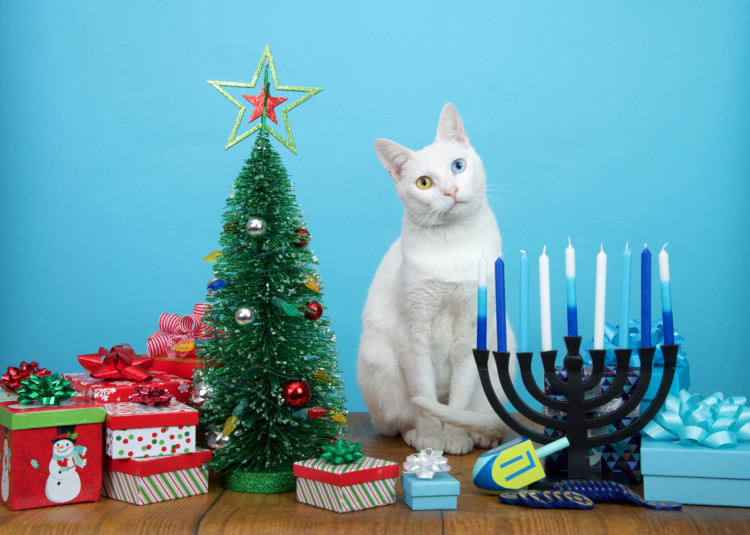 ‘Tis the season for celebrating, and we’re pulling out our tinsel and plastic Santas. The lights adorn our houses, or in some cases, a menorah is placed in the window, ready for December 10th to come around for the first night of Chanukah.
‘Tis the season for celebrating, and we’re pulling out our tinsel and plastic Santas. The lights adorn our houses, or in some cases, a menorah is placed in the window, ready for December 10th to come around for the first night of Chanukah.
We’re saying “Merry Christmas,” or “Happy Chanukah,” or “Happy Holidays,” or “Season’s Greetings” and almost every radio station has been taken over with Christmas Carols.
We’re in the mood for giving, for loving, for peace on Earth and goodwill towards man.
What are some traditions for these holidays? Let’s take a peek:
One of the common threads in the Jewish tradition of Chanukah is eating fried foods. Because many of the countries on our tour involve the food, let’s start by explaining why fried foods are important.
Chanukah is the “Festival of Lights.” It is a celebration of freedom of religion, where the Jewish people, having been pushed out of their homes and temples by a polytheistic King who tried to get them to worship him, refused. They took to the mountains and hid. Eventually, they formed a rebellion, won their lands and temple back, and began the recovery. In the temple there is an Eternal Flame. It is said that when the flame goes out, the Temple in Jerusalem will fall…so it’s important to keep it lit. Sadly, when they began their recovery, they discovered only enough oil to last for one day. They used this oil to light the flame and began preparing more oil, but they knew it took eight days for this to be ready. A miracle happened though, and the oil kept the flame lit for eight days! This is why Jewish people across the world eat fried foods on Chanukah.
And now, our tour begins in South America.
Jewish people in Columbia have added a new fried food to their menu: Patacones, which is plantain slices fried in oil.
Meanwhile, Christians celebrating Christmas have a few unusual traditions. In Venezuela, for example, roads are closed to let people roller skate to early morning Christmas Mass. On their way, skaters will tug on the ends of long pieces of string tied by children to their big toes and dangled out of windows. Why was this tradition begun? Nobody knows…but guesses are that it is the tropical Venezuela’s alternative to sledding.
Mexicans perform the “posadas” which is a series of nine processions to re-enact the part of the Christmas story where Joseph and Mary go in search of somewhere to stay. This ends in a Church service with food, games, and fireworks.
Moving our tour on to Africa, we come to Yemen and North Africa, where the seventh day of Chanukah is all about celebrating the heroines of the story. These communities mark this with Chag Ha’Banot, the Daughter’s Festival and celebrate Hannah and Judith, who fought against the oppression from the Assyrians. In Morocco, Jewish people also have a “Sfenj,” which is a fried jelly donut with juice and the zest of an orange.
Meanwhile, in South Africa, Christians enjoy their “tasty” Christmas treats of emperor moth caterpillars that are either sun-dried or deep fried. They say the bugs have a similar flavor to tea.
Continuing on to the Middle East, we have a few interesting traditions. In Israel, sufagniyot, round jelly donuts fried in oil, are enjoyed and menorah lights are burned and displayed for all to see them burning. In Istanbul, Turkey, Jewish people often sing a song in honor of the eight candles called “Ocho Candelas” and munch on fritters known as “burmelos.”
In Syria, Christians have its own local legend about the Nativity. Christmas presents are delivered, not by Father Christmas, but by the youngest of the camels that carried the three wise men to Bethlehem. Instead of a carrot for Rudolph, children leave water and hay outside their homes for this hard-working camel, and the load comes on New Year’s Eve instead of Christmas Eve.
Popping over to the Mediterranean, we can visit Jewish households chowing down on Precipizi, which is a fried pastry that involves a lightly sweetened, olive oil infused honey-covered treat.
Portugal’s Christian children eat a meal called a Consoada in the early hours of Christmas Day. They set extra places for “alminhas a penar…” the souls of the dead. Some believe that this is in hopes that the dead will provide a bountiful harvest.
There are many, many more Holiday traditions: Indian Jews dip wicks in coconut oil to light their menorahs, while Christian children there have Christmas banana trees or mango trees to light up instead of the Pine trees they lack.
Christmas brings more fun and funny traditions as well: In the Czech Republic, single Czech women stand with their backs to the front door on Christmas Eve and remove a shoe. They hurl it over their shoulder towards the door and how it lands predicts their romantic prospects for a year. If the toe faces the door, the thrower is destined to marry…sadly, the heel to the door is the opposite.
Whatever way you celebrate, and whichever holidays you observe, we wish you all an amazing Holiday Season!
